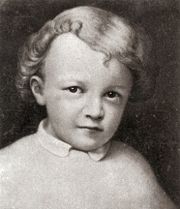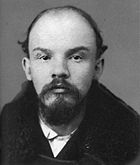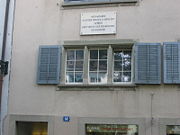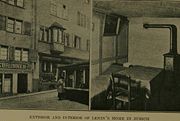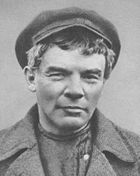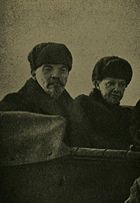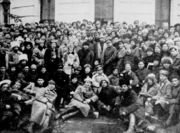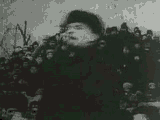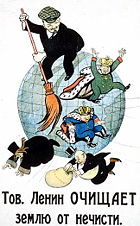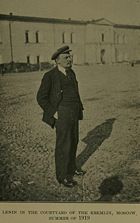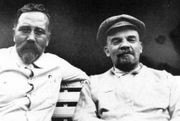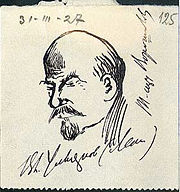Vladimir Lenin
2008/9 Schools Wikipedia Selection. Related subjects: Political People
|
Vladimir Lenin
Владимир Ильич Ленин |
|
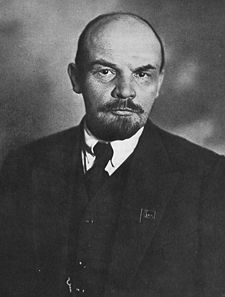 |
|
|
Chairman of the Council of People’s Commissars
|
|
|---|---|
| In office November 8, 1917 – January 21, 1924 |
|
| Preceded by | Alexander Kerensky (President of the Provisional Government) |
| Succeeded by | Alexei Rykov Joseph Stalin ( General Secretary of the Communist Party) |
|
|
|
| Born | April 22, 1870 (OS) Simbirsk, Russian Empire |
| Died | January 21, 1924 (aged 53) Gorki, Russian SFSR, Soviet Union |
| Nationality | Russian |
| Political party | Bolshevik Party |
| Spouse | Nadezhda Krupskaya |
| Profession | Politician, revolutionary |
Vladimir Ilyich Lenin (Russian: Влади́мир Ильи́ч Ле́нин), born Vladimir Ilyich Ulyanov (Russian: Влади́мир Ильи́ч Улья́нов), and also known by the pseudonyms VI Lenin, Nikolai Lenin and N. Lenin, ( April 22 [ O.S. April 10] 1870 – January 21, 1924), was a Russian revolutionary, a communist politician, the main leader of the October Revolution, the first head of the Russian Soviet Socialist Republic and from 1922, the first de facto leader of the Soviet Union. He was named by Time Magazine as one of the 100 most influential people of the 20th century. His contributions to Marxist theory are commonly referred to as Leninism.
Early life
Born in Simbirsk (renamed Ulyanovsk after its most famous son), in the Russian Empire, Lenin was the son of Ilya Nikolaevich Ulyanov and Maria Alexandrovna Ulyanova. His father was a successful Russian official in public education who wanted democracy. The family was of mixed ethnicity, his ancestry being “ Russian, Mordovian, Kalmyk, Jewish (see Blank family), Volgan German, and Swedish, and possibly others” according to biographer Dmitri Volkogonov. Lenin was baptized into the Russian Orthodox Church.
In 1886, Lenin’s father, a schoolmaster, died of a cerebral hemorrhage, and, in May 1887, when Lenin was 17 years old, his eldest brother Alexander was arrested and hanged for participating in a terrorist bomb plot threatening the life of Tsar Alexander III. His sister Anna, who was with Alexander at the time of his arrest, was banished to his family estate in the village of Kokushkino, about 40 km (25 mi.) from Kazan. This event radicalized Lenin, and his official Soviet biographies describe it as being central to the revolutionary track of his life. It is also significant, perhaps, that this emotional upheaval transpired in the same year as that which saw him enroll at the Kazan State University. A famous painting by Piotr Belousov, We Will Follow a Different Path, reprinted in millions of Soviet textbooks, depicted young Lenin and his mother grieving the loss of his elder brother. The phrase “We will follow a different path” refers to Lenin's choosing a Marxist approach to popular revolution, instead of anarchist or individualist methods. As Lenin became interested in Marxism, he was involved in student protests and was subsequently arrested. He was then expelled from Kazan University for his political ideas. He continued to study independently, however, and it was during this period of exile that he first familiarized himself with Karl Marx’s Das Kapital. Lenin was later permitted to continue his studies, this time at the University of Saint Petersburg, and, by 1891, had been admitted to the Bar. In January 1892 Lenin was awarded a first class degree in law by the University. He also distinguished himself in Latin and Greek, and learned German, French and English. His knowledge of the latter two languages was limited: he relied on Inessa Armand to translate an article into French and into English in 1917. In the same year he also wrote to S. N. Ravich in Geneva “I am unable to lecture in French.”
Revolutionary activity, travel and exile
Lenin practiced as a lawyer for some years in Samara, a port on the Volga river, before moving to St Petersburg in 1893. Rather than pursuing a legal career, he became increasingly involved in revolutionary propaganda efforts, joining the local Marxist group. On December 7, 1895, Lenin was arrested, held by authorities for fourteen months and then released and exiled to the village of Shushenskoye in Siberia, where he mingled with such notable Marxists as Georgy Plekhanov, who had introduced socialism to Russia.
In July 1898, Lenin married socialist activist Nadezhda Krupskaya and he published the book The Development of Capitalism in Russia in April 1899. In 1900, his exile came to an end, and he began his travels throughout Russia and the rest of Europe. Lenin lived in Zurich, Geneva (where he lectured and studied at Geneva University), Munich, Prague, Vienna, Manchester and London, and, during this time, he co-founded the newspaper Iskra (“The Spark”) with Julius Martov, who later became a leading opponent. He also wrote several articles and books related to the revolutionary movement, striving to recruit future Social Democrats. He began using various aliases, finally settling upon "Lenin"—"N. Lenin" in full.
Lenin was active in the Russian Social Democratic Labour Party (RSDLP; РСДРП in Russian) and, in 1903, led the Bolshevik faction after a split with the Mensheviks. The names ‘Bolshevik’, or ‘Majority’, and ‘Menshevik’, or ‘Minority’, referred to the narrow outvoting of the Mensheviks in the decision to limit party membership to revolutionary professionals, rather than including sympathizers. The division was inspired partly by Lenin’s pamphlet What Is to Be Done? (1901–02), which focused on his revolutionary strategy. It is said to have been one of the most influential pamphlets in pre-revolutionary Russia, with Lenin himself claiming that three out of five workers had either read it or had had it read to them.
In November 1905, Lenin returned from exile to Russia to support the 1905 Russian Revolution. In 1906, Lenin was elected to the Presidium of the RSDLP. At this time he shuttled between Finland and Russia but, in December 1907, with the revolution crushed by the Tsarist authorities, he returned back to European exile. Until the revolutions of 1917, he spent the majority of his time exiled in Europe, where, despite relative poverty, he managed to continue his political writings.
In response to philosophical debates on the proper course of a socialist revolution, Lenin completed Materialism and Empirio-criticism in 1909—a work which became fundamental in the Marxist-Leninist philosophy. Lenin continued to travel in Europe and participated in many socialist meetings and activities, including the Prague Party Conference of 1912. When Inessa Armand left Russia and settled in Paris, she met Lenin and other Bolsheviks living in exile, and it is believed that she was Lenin’s lover during this time. As writer Neil Harding points out however, although much has been made of this relationship, despite the “slender stock of evidence … we still have no evidence that they were sexually intimate”.
When the First World War began in 1914, and the large Social Democratic parties of Europe (at that time self-described as Marxist, and including luminaries such as Karl Kautsky) supported their various countries’ war efforts, Lenin was absolutely stunned, refusing to believe at first that the German Social Democrats had voted for war credits. This led him to a final split with the Second International, which was composed of these parties. Lenin (against the war in his belief that the peasants and workers were fighting the battle of the bourgeoisie for them) adopted the stance that what he described as an “imperialist war” ought to be turned into a civil war between the classes. As war broke out, Lenin was briefly detained by the Austrian authorities in the town of Poronin, where he was residing at the time. On 5 September 1914 Lenin moved to neutral Switzerland, residing first at Berne and then Zurich. In 1915 he attended the anti-war Zimmerwald Conference, convened in the Swiss town of that name. Lenin was the main leader of the minority Zimmerwald Left, who unsuccessfully urged against the majority pacifists that the conference should adopt Lenin's stance of converting the imperialist war into a class war. Lenin and the Zimmerwald Left urged a similar resolution at the next anti-war conference, also held in Switzerland at Kienthal (24-30 April 1916), but in the end settled for a compromise manifesto.
It was in Zurich in the spring of 1916 that Lenin wrote the important theoretical work Imperialism, the Highest Stage of Capitalism. In this work Lenin argues that the merging of banks and industrial cartels give rise to finance capital. According to Lenin, in the last stage of capitalism, in pursuit of greater profits than the home market can offer, capital is exported. This leads to the division of the world between international monopolist firms and to European states colonizing large parts of the world in support of their businesses. Imperialism is thus an advanced stage of capitalism, one relying on the rise of monopolies and on the export of capital (rather than goods), and of which colonialism is one feature.
Return to Russia
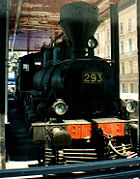
After the 1917 February Revolution in Russia and the abdication of Tsar Nicholas II, Lenin realized that he must return to Russia as soon as possible, but this was problematic because he was isolated in neutral Switzerland as the First World War raged throughout neighboring states. The Swiss communist Fritz Platten nonetheless managed to negotiate with the German government for Lenin and his company to travel through Germany by rail, on the so-called “ sealed train”. The German government clearly hoped Lenin’s return would create political unrest back in Russia, which would help to end the war on the Eastern front, allowing Germany to concentrate on defeating the Western allies. Once through Germany, Lenin continued by ferry to Sweden; the remainder of the journey through Scandinavia was subsequently arranged by Swedish communists Otto Grimlund and Ture Nerman.
On April 16, 1917, Lenin arrived by train to a tumultuous reception at Finland Station, in Petrograd. He immediately took a leading role within the Bolshevik movement, publishing the April Theses, which called for an uncompromising opposition to the provisional government. Initially, Lenin isolated his party through this lurch to the left. However, this uncompromising stand meant that the Bolsheviks were to become the obvious home for all those who became disillusioned with the provisional government, and with the “luxury of opposition” the Bolsheviks did not have to assume responsibility for any policies implemented by the government.
Meanwhile, Aleksandr Kerensky, Grigory Aleksinsky and other opponents of the Bolsheviks accused them and Lenin in particular of being paid German agents. In response Leon Trotsky, a prominent new Bolshevik leader, made a defensive speech on July 17, saying:
| “ | An intolerable atmosphere has been created, in which you as well as we are choking. They are throwing dirty accusations at Lenin and Zinoviev. Lenin has fought thirty years for the revolution. I have fought twenty years against the oppression of the people. And we cannot but cherish a hatred for German militarism. … I have been sentenced by a German court to eight months’ imprisonment for my struggle against German militarism. This everybody knows. Let nobody in this hall say that we are hirelings of Germany. | ” |
After the turmoil of the July Days, when workers and soldiers in the capital clashed with government troops, Lenin had to flee to Finland for safety, to avoid arrest by Kerensky. The Bolsheviks had not arranged the July Uprising. The time was still not ripe for revolution, claimed Lenin: the workers in the city were willing, but the Bolsheviks still needed to wait for the support of the peasants. During his short time in Finland, Lenin finished his book State and Revolution, which called for a new form of government based on workers’ councils, or soviets elected and revocable at all moments by the workers. After an abortive coup attempt by General Kornilov in late August the masses rallied to the Bolsheviks and their programme of 'peace, bread and land'.Imprisoned Bolshevik leaders were released and Lenin returned to Petrograd in October, inspiring the October Revolution with the slogan “All Power to the Soviets!” Lenin directed the overthrow of the Provisional Government from the Smolny Institute from the 6-8 November 1917. The storming and capitulation of the Winter Palace on the night of the 7th to 8th of November marked the beginning of Soviet rule.
Head of the Soviet state
On November 8, 1917, Lenin was elected as the Chair of the Council of People’s Commissars by the Russian Congress of Soviets.
“Communism is Soviet power plus the electrification of the entire country,” Lenin said, emphasizing the importance of bringing electricity to all corners of Russia and modernizing industry and agriculture:
| “ | We must show the peasants that the organisation of industry on the basis of modern, advanced technology, on electrification which will provide a link between town and country, will put an end to the division between town and country, will make it possible to raise the level of culture in the countryside and to overcome, even in the most remote corners of land, backwardness, ignorance, poverty, disease, and barbarism. | ” |
He initiated and supervised the devising and realisation of the GOELRO plan, the first-ever Soviet project for national economic recovery and development. He was very concerned about creating a free universal health care system for all, the rights of women, and teaching the illiterate Russian people to read and write. But first and foremost, the new Bolshevik government needed to take Russia out of the World War.
Faced with the imposing threat of a continuing German advance eastwards, Lenin argued that Russia should immediately sign a peace treaty. Other Bolshevik leaders, such as Bukharin, advocated continuing the war as a means of fomenting revolution in Germany. Trotsky, who led the negotiations, advocated an intermediate position, of “No War, No Peace”, calling for a peace treaty only on the conditions that no territorial gains on either side be consolidated. After the negotiations collapsed, the Germans renewed their advance, resulting in the loss of much of Russia’s western territory. As a result of this turn of events, Lenin’s position consequently gained the support of the majority in the Bolshevik leadership. On March 3, 1918, Lenin removed Russia from World War I by agreeing to the Treaty of Brest-Litovsk, under which Russia lost significant territories in Europe.

The Russian Constituent Assembly was shut down during its first session January 19 and the Bolsheviks in alliance with the left Socialist Revolutionaries then relied on support from the soviets.
The Bolsheviks had formed a coalition government with the left wing of the Socialist Revolutionaries. However, their coalition collapsed after the Social Revolutionaries opposed the Brest-Litovsk treaty, and joined other parties in seeking to overthrow the Bolshevik government. Lenin responded to these efforts by a policy of wholesale persecution, which included jailing some of the members of the opposing parties.
From early 1918, Lenin campaigned for a single individual (accountable to the state to which the workers could ask for measures) to be put in charge of each enterprise (workers having to obey him until it was changed by the state), contrary to most conceptions of workers' self-management, but absolutely essential for efficiency and expertise according to Lenin (it was argued by most proponents of self-management that the intention behind this move was to strengthen state control over labour and that the failures of self-management were mostly because of lack of resources —a problem the government itself could not solve as his licensing for a month of all workers of most factories proved). As S.A. Smith wrote: “By the end of the civil war, not much was left of the democratic forms of industrial administration promoted by the factory committees in 1917, but the government argued that this did not matter since industry had passed into the ownership of a workers’ state.”
Lenin had a certain admiration for the Irish socialist revolutionary James Connolly, and the Soviet Union was the first country to recognize the Irish Republic which fought a war of independence against Britain. He would often meet with the famous revolutionary’s son, Roddy Connolly and developed a close friendship with him.
Creation of the secret police
To protect the newly-established Bolshevik government from counterrevolutionaries and other political opponents, the Bolsheviks created a secret police, the Cheka, in December 1917.
The Bolsheviks had planned to hold a trial for the former Tsar, but in July 1918, when the White Army was advancing on Yekaterinburg where the former royal family was being held, Sverdlov acceded to the request of the local Soviet to execute the Tsar right away, rather than having him freed by the Whites. The Tsar and the rest of his immediate family were executed, though whether this was a decision of the central government or the local Soviet remains the subject of historical dispute. Lenin was informed about the execution only after it had taken place, but did not criticize it. Censorship was quickly imposed, and it was up to the Cheka to confiscate the literature of dissident workers: “[On] 17 November the Central Executive Committee passed a decree giving the Bolsheviks control over all newsprint and wide powers of closing down newspapers critical of the regime…” (Leonard Shapiro, The Communist Party of the Soviet Union). Workers were re-forming independent soviets; the Cheka broke them up. Independent newspapers criticized Lenin’s government; the Cheka closed them down, until the Bolshevik-controlled Pravda and Izvestia had a monopoly on the supply of news. Shapiro asserts that “The refusal to come to terms with the socialists and the dispersal of the Constituent assembly led to the logical result that revolutionary terror would now be directed not only against traditional enemies, such as the bourgeoisie or right-wing opponents, but against anyone, be he socialist, worker or peasant, who opposed Bolshevik rule.”
Assassination attempts
On January 14, 1918, an assassination attempt on Lenin was made in his car in Petrograd by unrecognizable gunmen. Lenin and Fritz Platten were in the back of the car together, after having given a public speech. When the shooting started, “Platten grabbed Lenin by the head and pushed him down. … Platten’s hand was covered in blood, having been grazed by a bullet as he was shielding Lenin.”
On August 30, 1918, Fanya Kaplan, a member of the Socialist Revolutionary Party, approached Lenin after he had spoken at a meeting and was on the way to his car. He had his foot on the running board. She called out to Lenin, who turned to answer. She immediately fired three shots hitting Lenin twice: one bullet, relatively harmless, lodged in the arm; the second round, more seriously entering at the juncture of Lenin’s jaw and neck, the third shot striking a woman who was talking with Lenin when the shooting began. Lenin fell to the ground, unconscious. He was taken to his apartment in the Kremlin, refusing to venture to a hospital since he believed that other assassins would be waiting there. Doctors were summoned but decided that it was too dangerous to remove the bullets. While Lenin began his slow recovery Pravda ridiculed Kaplan as a latter-day Charlotte Corday; assuring its readers that immediately after the shooting: “Lenin, shot through twice, with pierced lungs, spilling blood, refuses help and goes on his own. The next morning, still threatened with death, he reads papers, listens, learns, and observes to see that the engine of the locomotive that carries us towards global revolution has not stopped working…” Although Lenin had no “pierced lungs”, the potentially fatal neck-jaw wound had allowed blood to enter one of his lungs, which is still a very serious condition.
Other than similar exhortation by the press, little was revealed to the Russian public — either about the attempted assassination, the suspect, or Lenin’s condition. Historian Richard Pipes wrote, “The impression one gains … is that the Bolsheviks deliberately underplayed the event to convince the public that whatever happened to Lenin, they were firmly in control.”
Popular reaction to the assassination attempt on Lenin was described at the time by Leonid Krasin, who wrote to his wife on 7 Sept 1918:
- “As it happens, the attempt to kill Lenin has made him much more popular than he was. One hears a great many people who are far from having any sympathy with the Bolsheviks, saying that it would be an absolute disaster if Lenin had succumbed to his wounds, as it was first thought he would. And they are quite right, for in the midst of all this chaos and confusion he is the backbone of the new body politic, the main support on which everything rests”
A personal cult of Lenin, which he himself tried to discourage, began with this incident. Lenin’s health declined from this point. It is believed by some that the incident contributed to his later strokes.
Lenin and the Red Terror
Following the assassination attempt on Lenin and the successful assassination of Petrograd chief of secret police Moisei Uritsky, Stalin, in a telegram argued that a policy of “open and systematic mass terror” be instigated against “those responsible”. The other Bolsheviks agreed, and instructed Felix Dzerzhinsky, whom Lenin had appointed to head the Cheka in 1917, to commence a “ Red Terror”, which was officially announced to the public on September 1, 1918, by the Bolshevik newspaper, Krasnaya Gazeta. According to Christopher Read, at this time, due to the assassination attempt by Kaplan, Lenin was lying severely wounded in hospital and was too ill to advise retaliatory measures. But while recovering from his wounds, Lenin instructed: "It is necessary - secretly and urgently to prepare the terror." Suspected enemies could expect brutal torture, flogging, maiming or execution. Some were shot, others drowned, buried alive, or hacked to death by swords. Quite often those about to be executed were forced to dig their own graves. The only published Soviet statistics regarding Cheka executions are the semi-official ones provided by the Chekist Martin Latsis, limited to RSFSR over the period 1918–1920, giving the grand total of 12,733 executed, including 3,082 for taking part in rebellions, 2,024 for membership of counter-revolutionary organisations, 643 for gangsterism, 455 for incitement to revolution, 206 for corruption, 102 for desertion and the same number for espionage. These statistics are considered by many scholars to be decidedly understated, as they did not embrace Ukraine or the Crimea. In the latter at least 50,000 people were shot or hanged after General Wrangel was put down at the end of 1920. Some historians estimate that between 1917 and 1922 up to 280,000 people were killed by the Chekas, of which about half perished through summary executions and the other half through the suppression of rebellions (e.g. Tambov Rebellion). Orlando Figes goes so far as to assert that it is possible more people were killed by the Cheka than died in battle. During the Civil War, atrocities were carried out by both Reds and Whites.
According to the Black Book of Communism, in May 1919 there were 16,000 people in labour camps based on the old Tsarist katorga labour camps, and in September 1921 there were more than 70,000. Lenin's Hanging Order documents that Lenin himself ordered terror on 11 August 1918.
According to Orlando Figes, Lenin had always been an advocate of “mass terror against enemies of the revolution” and was open about his view that the proletarian state was a system of organized violence against the capitalist establishment. Figes also claims that the terror, while encouraged by the Bolsheviks, had its roots in a popular anger against the privileged. When Kamenev and Bukharin tried to curb the “excesses” of the Cheka in late 1918, it was Lenin who defended it. Lenin remained an advocate of mass terror. In a letter of March 19, 1922, to Molotov and the members of the Politburo, following an uprising by the clergy in the town of Shuia, Lenin outlined a brutal plan of action against the clergy and their followers, who were defying the government decree to remove church valuables: “We must (…) put down all resistance with such brutality that they will not forget it for several decades. (…) The greater the number of representatives of the reactionary clergy and reactionary bourgeoisie we succeed in executing (…) the better.” According to Church records, 2,691 priests, 1,962 monks and 3,447 nuns were killed that year.
In September 1918, during the Red Terror, 25 former tsarist ministers and high civil servants along with 765 so-called White Guards were shot in Moscow. Lenin personally signed the execution lists. Despite this attempt by Lenin to stop them the Whites continued active and indulged in a massive anti-Red terror and also pogroms against the Jews. For instance the Whites killed 115,000 Ukrainian Jews in 1919 alone. According to historian Christopher Read the numbers killed by the White forces were on a comparable scale to the Bolsheviks and probably can be numbered in hundreds of thousands. But, according to The Black Book of Communism, the two types of terror were not on the same level. The Red Terror, which was official policy, was more systematic, better organized, and targeted at whole social classes. The White Terror was never systematized in such a fashion, and was almost invariably the work of detachments that were taking measures not authorized by the military command.
Russian Communist Party and civil war
| Communist Party of the Soviet Union |
|
Party History |
|
Party Organization |
|
Leaders |
|
Pravda |
| Communism Portal |
In March 1919, Lenin and other Bolshevik leaders met with revolutionary socialists from around the world and formed the Communist International. Members of the Communist International, including Lenin and the Bolsheviks themselves, broke off from the broader socialist movement. From that point onwards, they would become known as communists. In Russia, the Bolshevik Party was renamed the “ Russian Communist Party (Bolsheviks),” which eventually became the CPSU.
Meanwhile, the civil war raged across Russia. A wide variety of political movements and their supporters took up arms to support or overthrow the Soviet government. Although many different factions were involved in the civil war, the two main forces were the Red Army (communists) and the White Army (traditionalists). Foreign powers such as France, Britain, the United States and Japan also intervened in this war (on behalf of the White Army). Eventually, the more organisationally proficient Red Army, led by Leon Trotsky, won the civil war, defeating the White Russian forces and their allies in 1920. Smaller battles continued for several more years, however.
The civil war has been described as one “unprecedented for its savagery,” with mass executions and other atrocities committed by both sides. Between battles, executions, famine and epidemics, many millions would perish.
In late 1919, successes against the White Russian forces convinced Lenin that it was time to spread the revolution to the West, by force if necessary. When the newly independent Second Polish Republic began securing its eastern territories annexed by Russia in the partitions of Poland in the late 18th century, it clashed with Bolshevik forces for dominance in these areas, which led to the outbreak of the Polish-Soviet War in 1919. With the revolution in Germany and the Spartacist League on the rise, Lenin viewed this as the perfect time and place to “probe Europe with the bayonets of the Red Army.” Lenin saw Poland as the bridge that the Red Army would have to cross in order to link up the Russian Revolution with the communist supporters in the German Revolution, and to assist other communist movements in Western Europe. However the defeat of Soviet Russia in the Polish-Soviet War invalidated these plans.
Lenin was a harsh critic of imperialism. In 1917 he declared the unconditional right of separation for national minorities and oppressed nations. However, when the Russian Civil War was won he used military force to assimilate the newly independent states of Armenia, Georgia, and Azerbaijan. He argued that the inclusion of those countries into the newly emerging Soviet government would shelter them from capitalist imperial ambitions.
During the civil war, as an attempt to maintain food supply to the cities and the army in the conditions of economic collapse, the Bolsheviks adopted the policy of war communism. That involved “requisitioning” supplies from the peasantry for little or nothing in exchange. This led the peasants to drastically reduce their crop production. Additionally, according to the official Bolshevik view which is still shared by some Marxists, rich peasants ( kulaks) withheld grain in order to increase their profits — statistics indicate that most of the grain and the other food supplies passed through the black market. Then, the Bolshevik requisitions came to affect the food that peasants had grown for their own subsistence and their seed grain. The resulting conflicts began with the Cheka and the army shooting hostages, and, according to The Black Book of Communism, ended with a second full-scale civil war against the peasantry, including the use of poison gas, death camps, and deportations. The same source emphasizes that in 1920, Lenin ordered increased emphasis on the food requisitioning from the peasantry, at the same time as the Cheka gave detailed reports about the large scale famine. The long war and a drought in 1921 also contributed to the famine. Estimates on the deaths from this famine are between 3 and 10 million.
The long years of war, the Bolshevik policy of war communism, the Russian famine of 1921, and the encirclement of hostile governments took their toll on Russia, however, and much of the country lay in ruins. There were many peasant uprisings, the largest being the Tambov rebellion. After an uprising by the sailors at Kronstadt in March 1921, Lenin replaced the policy of War Communism with the New Economic Policy (NEP), in a successful attempt to rebuild industry and especially agriculture. The new policy was based on recognition of political and economic realities, though it was intended merely as a tactical retreat from the socialist ideal. The whole policy was later reversed by Stalin.
Lenin's stance on anti-Semitism
The chaotic years of World War I, the February and October Revolutions, and the Civil War were fertile ground for the antisemitism that was endemic to tsarist Russia. During the war, Jews were accused of sympathizing with Germany and often persecuted. Russian anti-semitism continued even after the lifting of official anti-Jewish restrictions by the February regime and the Bolsheviks. Pogroms were unleashed throughout the Civil War, perpetrated by virtually every competing faction, from anarchists, to Polish and Ukrainian nationalists to the Red and White Armies. Continuing the policy of the Bolsheviks before the Revolution, Lenin and the Bolshevik Party strongly condemned the pogroms, including official denunciations in 1918 by the Council of People's Commissars. Opposition to the pogroms and to manifestations of Russian anti-semitism in this era were complicated by both the official bolshevik policy of assimilationism towards all national and religious minorities, and concerns about overemphasizing Jewish concerns for fear of exacerbating popular anti-semitism, as the White forces were openly identifying the Bolshevik regime with Jews.
Lenin was intrigued with technology and in 1919 recorded eight of his speeches on gramophone records. Seven were later re-recorded and put on sale in the Khrushchev era. Significantly the one which was suppressed outlined Lenin’s feelings on anti-Semitism:
| “ | The Tsarist police, in alliance with the landowners and the capitalists, organized pogroms against the Jews. The landowners and capitalists tried to divert the hatred of the workers and peasants who were tortured by want against the Jews. … Only the most ignorant and downtrodden people can believe the lies and slander that are spread about the Jews. … It is not the Jews who are the enemies of the working people. The enemies of the workers are the capitalists of all countries. Among the Jews there are working people, and they form the majority. They are our brothers, who, like us, are oppressed by capital; they are our comrades in the struggle for socialism. Among the Jews there are kulaks, exploiters and capitalists, just as there are among the Russians, and among people of all nations… Rich Jews, like rich Russians, and the rich in all countries, are in alliance to oppress, crush, rob and disunite the workers… Shame on accursed Tsarism which tortured and persecuted the Jews. Shame on those who foment hatred towards the Jews, who foment hatred towards other nations. | ” |
Lenin was supported by the Labour Zionist ( Poalei Zion) movement, then under the leadership of Marxist theorist Ber Borochov, which was fighting for the creation of a Jewish workers' state in Palestine and also participated in the October Revolution (and in the Soviet political scene afterwards until being banned by Stalin in 1928). While Lenin remained opposed to outward forms of anti-semitism (and all forms of racism), allowing Jewish people to rise to the highest offices in both party and state, certain historians such as Dmitri Volkogonov argue that the record of his government in this regard was highly uneven. A former official Soviet historian turned staunch anti-communist, Volkogonov claims that Lenin was aware of pogroms carried out by units of the Red Army during the war with Poland, though the whole issue was effectively ignored. Volkogonov writes that “While condemning anti-Semitism in general, Lenin was unable to analyze, let alone eradicate, its prevalence in Soviet society”. Likewise, the hostility of the Soviet regime towards all religion made no exception for Judaism, and the 1921 campaign against religion saw the seizure of many synagogues (whether this should be regarded as anti-Semitism is a matter of definition since Orthodox churches received the same treatment).
However, according to Jewish historian Zvi Gitelman: “Never before in Russian history — and never subsequently has a government made such an effort to uproot and stamp out anti-Semitism”.
Later life and death
Lenin’s health had already been severely damaged by the strains of revolution and war. The assassination attempt earlier in his life also added to his health problems. The bullet was still lodged in his neck, too close to his spine for medical techniques of the time to remove. In May 1922, Lenin had his first stroke. He was left partially paralyzed on his right side, and his role in government declined. After the second stroke in December of the same year, he resigned from active politics. In March 1923, he suffered his third stroke and was left bedridden for the remainder of his life, no longer able to speak.
After his first stroke, Lenin dictated to his wife several papers regarding the government. Most famous of these is Lenin's Testament, which was partially inspired by the 1922 Georgian Affair and among other things criticized top-ranking communists, including Joseph Stalin, Grigory Zinoviev, Lev Kamenev, Nikolai Bukharin and Leon Trotsky. Of Stalin, who had been the Communist Party’s general secretary since April 1922, Lenin said that he had “unlimited authority concentrated in his hands”. He suggested that “comrades think about a way of removing Stalin from that post” because his rudeness would become “intolerable in a Secretary-General”. Upon Lenin’s death, his wife mailed his Testament to the central committee, to be read at the 13th Party Congress in May 1924. However, the committee and especially the ruling “ triumvirate” — Stalin, Kamenev and Zinoviev — had a vested interest in not releasing the will to the wider public. Lenin’s Testament was first officially published in 1925 in the United States by Max Eastman. In the same year, Trotsky wrote an article that downplayed its significance, stating that Lenin’s notes should not be regarded as a “will” and had neither been concealed nor violated. He did invoke it in his polemic against Stalin on later occasions, while in exile.
Lenin died at 18:50 Moscow time on January 21, 1924, aged 53, at his estate in Gorki Leninskiye. Over 900,000 people passed through the Hall of Columns during the four days and nights that Lenin lay in state. Large sections of the population in other countries expressed their grief at the death of Lenin. Speaking at a memorial meeting, Chinese premier Sun Yat-sen. said:
Through the ages of world history thousands of leaders and scholars appeared who spoke eloquent words, but these remained words. You, Lenin, were an exception. You not only spoke and taught us, but translated your words into deeds. You created a new country. You showed us the road of joint struggle... You, great man that you are, will live on in the memories of the oppressed people through the centuries.
The city of Petrograd was renamed Leningrad in his honour three days after Lenin’s death. This remained the name of the city until the disintegration of the Soviet Union in 1991, when it reverted to its original name, St. Petersburg, even though its administrative area kept the name (Leningrad Oblast)
During the early 1920s the Russian movement of cosmism was so popular that Leonid Krasin and Alexander Bogdanov proposed to cryonically preserve Lenin’s body in order to revive him in the future. Necessary equipment was purchased abroad, but for a variety of reasons the plan was not realized. Instead his body was embalmed and placed on permanent exhibition in the Lenin Mausoleum in Moscow on January 27, 1924.
After death
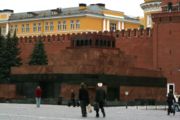
Lenin’s preserved body is on permanent display at the Lenin Mausoleum.
Because of Lenin’s unique role in the creation of the first Communist state, and despite his expressed wish shortly before his death that no memorials be created for him, his character was elevated over time to the point of near religious reverence. By the 1980s, every city in the Soviet Union had a statue of Lenin in its central square, either a Lenin street or a Lenin Square near the centre, and often 20 or more smaller statues and busts throughout its territory. Collective farms, medals, hybrids of wheat, and even an asteroid were named after him. Lenin’s life became the subject of nursery rhymes and children’s storytelling.
Since the fall of the Soviet Union, the level of reverence for Lenin in post-Soviet republics has declined considerably, though he is still considered an important figure by generations who grew up during the Soviet period. Most statues of Lenin have been torn down in Eastern Europe, but many still remain in Russia and ex-Soviet Central Asia. In 1991, following a close vote and political battles between communists and liberals the city of Leningrad returned to its original name, St Petersburg, whilst the surrounding Leningrad Oblast retained Lenin’s name. The citizens of Ulyanovsk, Lenin’s birthplace, have so far resisted all attempts to revert its name to Simbirsk. The subject of interring Lenin’s body has been a recurring topic for the past several years in Russia.
Censorship of Lenin in the Soviet Union
Lenin’s writings were carefully censored under the Soviet regime after his death. In the early 1930s, it became accepted dogma under Stalin to assume that neither Lenin nor the Central Committee could ever be wrong. Therefore, it was necessary to remove evidence of situations where they had actually disagreed, since in those situations it was impossible for both to have been right at the same time. Trotsky was a particularly vocal critic of these practices, which he saw as a form of deification. Later, even the fifth “complete” Soviet edition of Lenin’s works (published in 55 thick volumes between 1958 and 1965) left out parts that either contradicted dogma or showed their author in too poor a light.
